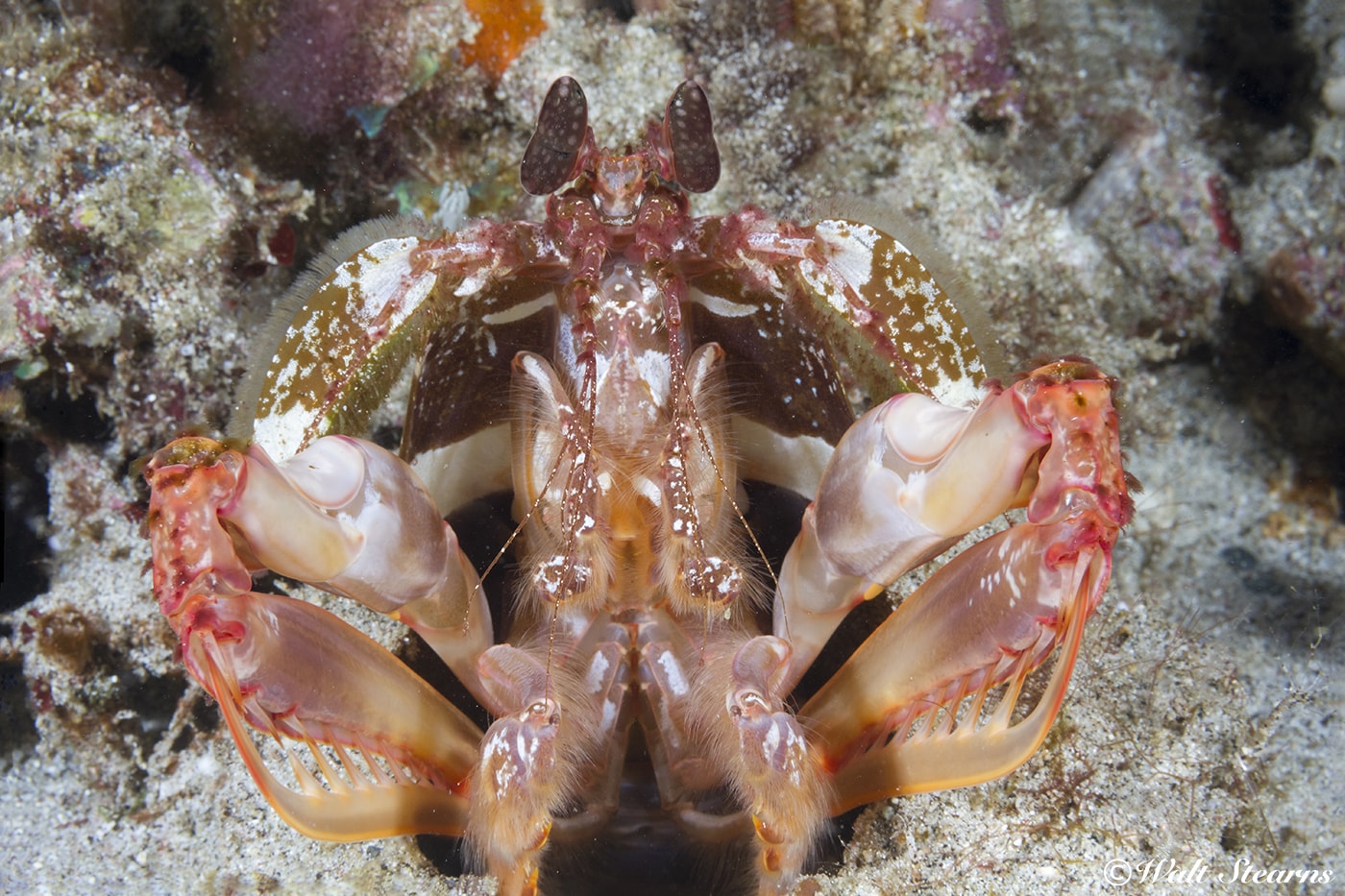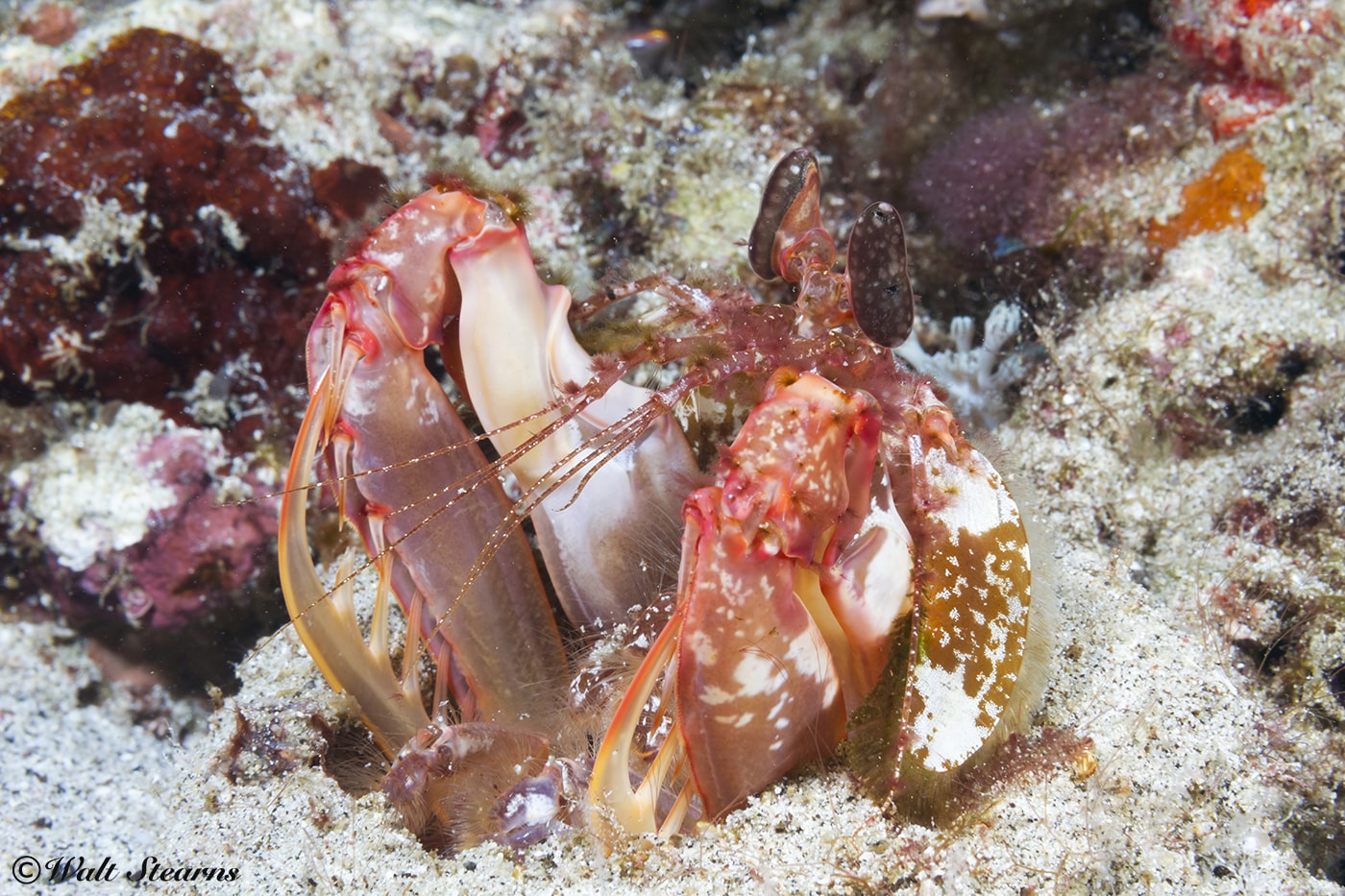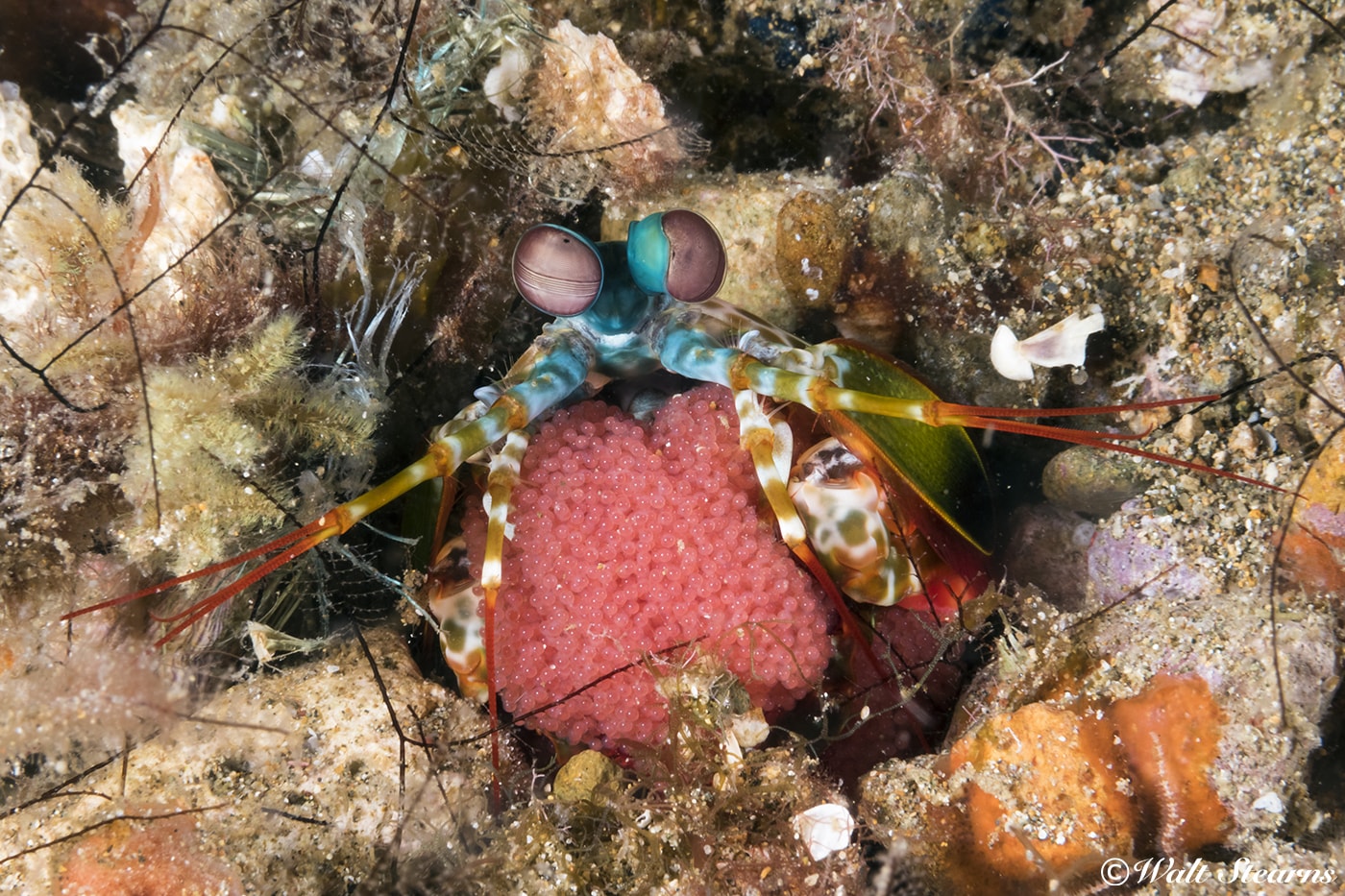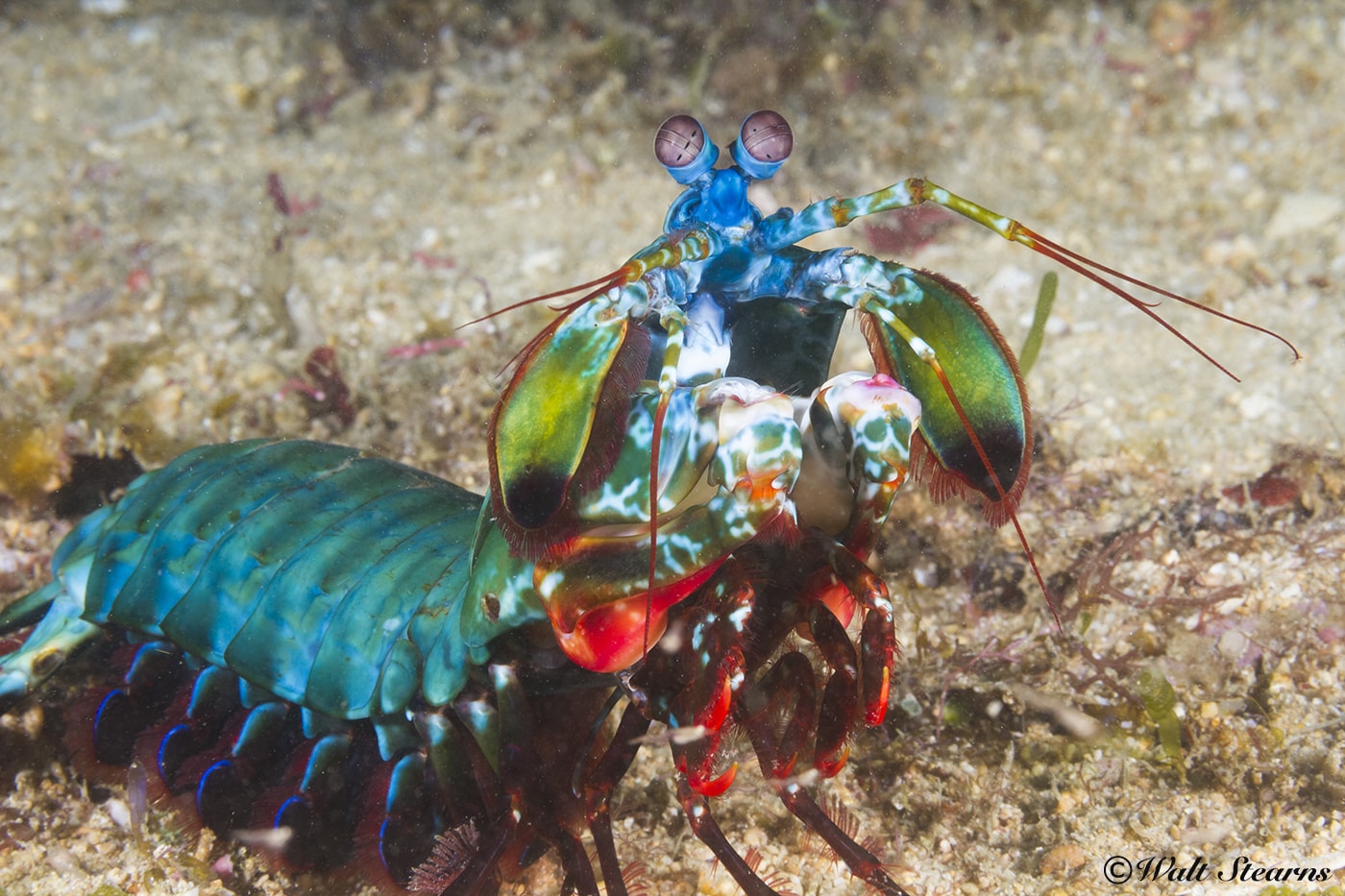
Imagine a ruthless attack predator, lurking in hidden corners of the reef. It has stalk-mounted eyes that provide trinocular vision and multispectral imaging capabilities. Its lightning-fast claws can spear or smash prey with the speed of a bullet, and its three-layer armor plating is more advanced than anything the military possesses. Would you believe it's a.... shrimp?

Not a Wimpy Shrimp
Unlike their foraging caridina cousins—which include the varieties we enjoy in a shrimp cocktail—mantis shrimp are aggressive hunters who go after crustaceans and small fish. They can also grow to sizes you'd not normally associate with the word shrimp. Some species can reach lengths of a foot or more, and the largest on record is an 18-inch monster found in Florida waters. There are more than 400 species of mantis shrimp living in the tropical waters of the world, and in many areas, they are one of the most prevalent predators in the reef environment. The reason they aren't commonly seen by the diver is that these shrimp spend most of their time in burrows dug into coral rubble or a soft sea bed. They only emerge to hunt or to collect building materials for their underground lairs. So if you are lucky enough to come across one out in the open, you might want to pause and watch. Just remember not to touch, or you might have the misfortune to learn why these unusual creatures are called “thumb splitters” in some parts of the world.

Spearers and Smashers
Mantis shrimp are usually divided into two categories, based both on physical differences and the way they attack. Many species are armed with sharp claws sporting barbed tips, which are used to stab and snag prey. These are known as the spearers. They usually hunt softer targets such as fish, which they impale and then shred. Other varieties have developed club-like claws that are used like a hammer to bludgeon and smash their victims. They are the smashers.
You might not think that a shrimp could pack a strong punch, but the sheer speed of the smasher's swing is so great that the armored claw actually superheats the surrounding water, creating shock waves that add to the already significant force of the blow. When put into aquarium tanks, smashing mantis shrimp have been known to break the glass. In the wild, these powerful hammers are used to bludgeon mollusks, crabs and oysters. Many smashers also pack a backup weapon in the form of a smaller spear-like claw, which is used mostly to slice up meals, or when fighting with other mantis shrimp. Given the lethality of both spears and hammers and the notoriously voracious appetites of these shrimp, it's probably a good thing that they don't grow to sizes that would put divers on the menu. Instead, the tables are often turned, as mantis shrimp appear on the dinner plate in many cultures around the world.

The Eyes Have It
The old saying that there's more than one way to look at things is certainly true for mantis shrimp. Their alien-like eyes see in ways that seem like the stuff of science fiction. Each of their compound eyes contain up to ten thousand individual receptors, which register light in 12 different color channels—we humans only see in three. Mantis shrimp use ultraviolet light waves to see the underwater world in ways invisible to other animals. They can tune their low-spectrum vision to match the environment, and have multiple modes of polarized vision, which further enhances their visual acuity. Like many other crustaceans, their eyes are mounted on stalks, and both eyes can pivot individually to look forward, sideways or back independently.
Mantis shrimp have one more visual enhancement that makes them even more lethal as strike predators. Each eye is divided into three sections in order to create trinocular vision. Most animals need both eyes to create binocular vision, which is what provides depth perception. With two eyes capable of independent trinocular vision, a mantis shrimp has pinpoint depth perception, which allows it to spear or smash with great precision. The many unique characteristics of a mantis shrimp's vision also allow them to lock in on semi-transparent prey, detect the presence of a would-be predator at greater range, and register florescence of coral and animals, similar to what divers now experience during a night “fluo-dive”.

Life in the Hole
Mantis shrimp spend most of their time in burrows. If you come across at circular hole in the sea floor, it might be the entrance to a lair. Inside, there may be a network of tunnels, with walls shored up by small rocks or bits of coral rubble. In fact, your best chance of actually seeing a mantis shrimp would be when it is either tossing debris out of the burrow or scavenging the nearby surroundings for new building material. Some of these shrimp are solitary, while others pair up and form a monogamous lifetime relationship. Since these shrimp can live for 20 years or more, these pair bonds are statistically more lasting than human marriages. They are thought to mate once or twice a year, and produce eggs that may be laid within the burrow, or carried on the female's body.

Lessons from a Shrimp
Given their many unique abilities, it is not surprising that mantis shrimp are a favorite subject of scientific research. The ways they process light may lead to advances in optical recognition technology and their hammer claws are of special interest to materials engineers. The extreme impacts that these claws are subjected to with each high-speed strike would shatter most substances in nature. Yet somehow, mantis shrimp can make tens of thousands of strikes with a club without causing damage. Research has revealed that these clubs are made up of a three-layer mineral composite that uses a combination of stiffness, hardness and absorption to create a form of armor that can absorb tremendous impact forces while containing any cracking that might occur within the composite. It's a technology that is now being studied by engineers looking to develop lighter, stronger and more impact-resistant materials for use in the military, medical, and aerospace industries.

The mantis shrimp is just one more example of the many unique life forms that await discovery in the oceans of the world. So the next time you happen across a hole in the sea floor, stick around for a few moments because you might catch a glimpse of a creature that is every bit as unusual and intriguing as anything dreamed up by science fiction.